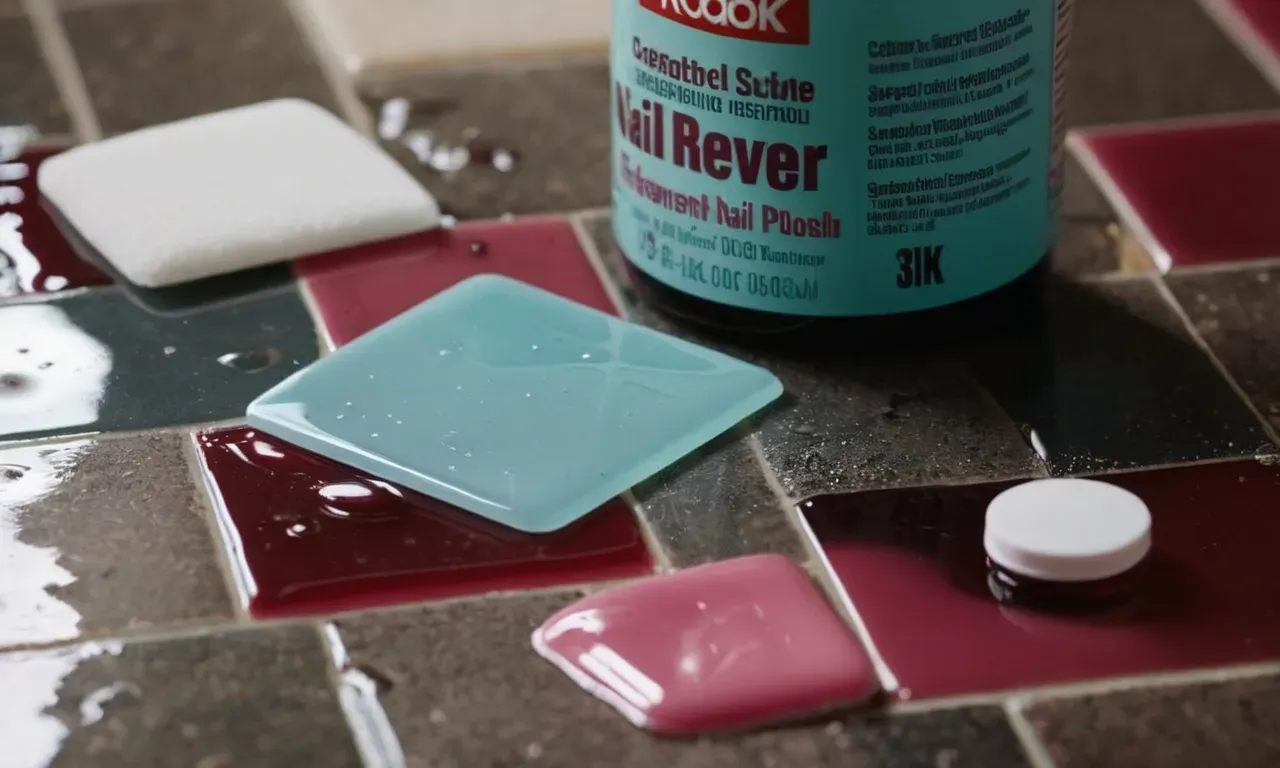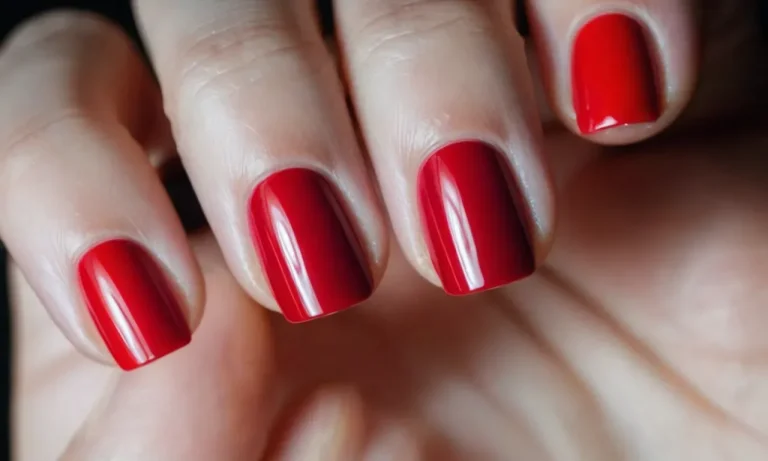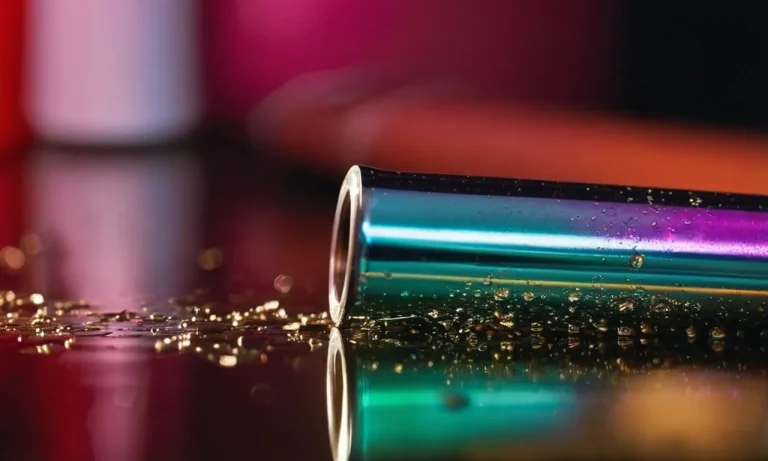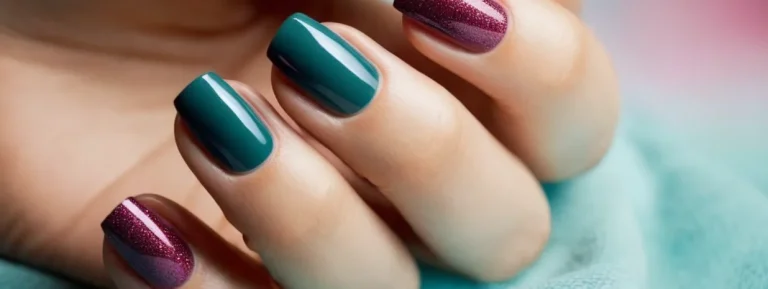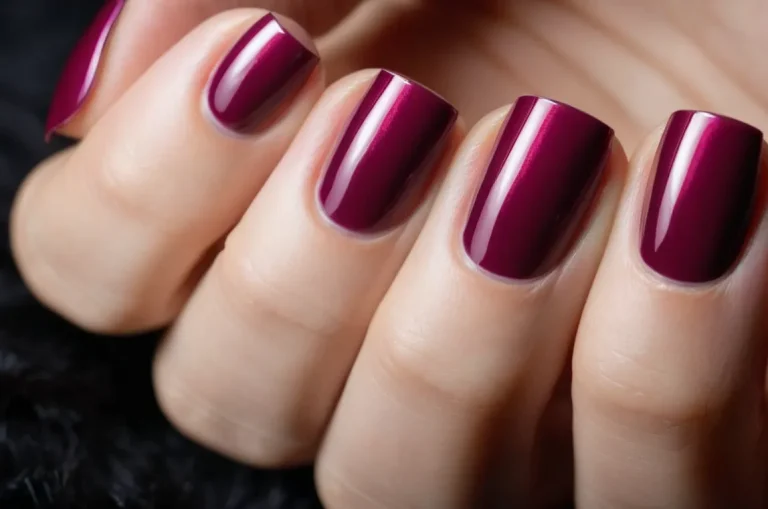How To Get Nail Polish Off Tile: A Complete Guide
Removing nail polish from tile can be a frustrating task, but it doesn’t have to be. With the right techniques and products, you can easily get those pesky polish stains off your tile surfaces. In this comprehensive guide, we’ll walk you through the step-by-step process to clean nail polish off tile floors, walls, countertops and more.
If you’re short on time, here’s a quick answer: use nail polish remover, rubbing alcohol or acetone on a cotton pad to gently rub the stained area. The solvents in these products will break down the nail polish so you can wipe it away. Repeat as needed until the stain is gone.
Assess the Stain
Determine the tile type
When attempting to remove nail polish from tile, the first step is to identify the type of tile. Common tile materials like ceramic, porcelain, and natural stone react differently to nail polish removers.
Ceramic and porcelain tiles have a protective glaze that resists stains, while natural stone is more porous and prone to absorbing spills. Once you know the tile type, you can select an appropriate remover method.
According to a 2021 survey from the HomeAdvisor, the most popular types of tile in homes are:
- Ceramic – 43%
- Porcelain – 29%
- Natural stone (granite, marble, etc.) – 17%
- Glass – 7%
- Mosaic – 4%
Within these categories, there is variation in glaze type, porosity, and other characteristics that impact stain removal. Always check the manufacturer specifications if possible. An unglazed ceramic floor tile will be more stain-prone than a ceramic wall tile with a protective glazing.
Figure out polish color and finish
Nail polishes come in a rainbow of colors and a variety of finishes from glossy to matte. Darker, pigmented polishes tend to stain surfaces more than light colors. And thicker, glossy formulas may leave behind more residue.
If the spilled polish has dried already, take note of the color and finish. This will help inform the removal process. For example, a thick layer of glittery purple polish will likely require more effort to eliminate than a small splatter of neutral sheer polish.
| Polish Color and Finish | Removal Difficulty |
|---|---|
| Sheer and neutral tones | Easier |
| Dark colors | Moderate |
| Heavy glitters and metallics | More difficult |
If the spill is still wet, blot it immediately with an absorbent cloth before the polish dries and adheres to the tile. This will make cleanup much simpler.
Knowing the tile type and polish details allows you to plan the most effective nail polish removal approach. With porcelain or ceramic tile, gentle solvents can often dissolve the stain. But absorbent natural stone may require poultices to draw out deeply-set spills.
Gather Your Supplies
Acetone or nail polish remover
Acetone-based nail polish remover is the most effective product for removing dried nail polish from tile. Choose a 100% acetone formula without additives like colors or fragrance, as these can leave residue behind. Pure acetone works quickly to break down the nail polish so you can wipe it away.
| Product | Price | Where to Buy |
| Onyx Professional 100% Acetone | $5 | Sally Beauty |
| Beauty Secrets 100% Acetone | $3 | Walmart |
Rubbing alcohol
Rubbing alcohol (70% isopropyl) works similarly to acetone to break down residue. It may take a bit more scrubbing than acetone. Look for a formula without additives or fragrances.
Cotton pads, cotton balls, rags or paper towels
You’ll need something absorbent to apply the remover and scrub the tile. Cotton pads, balls, and rags work well and can be rinsed and reused. Paper towels also work but will need to be discarded after each use.
Toothbrush or other small scrub brush
A toothbrush, grout brush, or other small scrub brush helps agitate the polish to remove it. Look for brushes with sturdy, non-metal bristles.
Gloves and eye protection
Wearing gloves prevents exposure of your skin to the harsh chemicals in nail polish remover and rubbing alcohol. Eye protection like safety goggles defends your eyes against splashes.
pH-neutral tile cleaner
After removing the polish, wash the tiles with a pH-balanced or alkaline cleaner made for tile. This helps eliminate any residue or acetone smell left behind. Prevent damaging the tile with acidic cleaners.
| Product | Price |
| Method All-Purpose Natural Surface Cleaner | $4 |
| Better Life Natural Tile Cleaner | $7 |
Scrub sponge
A mildly abrasive scrub sponge helps scrub off stubborn polish. Look for a sponge made specifically for scrubbing like those made with a scouring pad on one side.
Microfiber cloths
Microfiber cloths are lint-free, reusable cloths that help wipe up remover and scrubbed off polish. They can be rinsed and reused multiple times before needing to be laundered.
Remove the Stain
Apply the solvent
The first step when attempting to remove nail polish from tile is to apply a cleaning solvent directly to the stained area. Helpful solvents include nail polish remover containing acetone, rubbing alcohol, or non-acetone nail polish remover.
Pour a small amount of the solvent directly onto the stain, ensuring it covers the entire affected area. Allow it to soak into the tile and polish for 2-3 minutes so it can break down the staining components.
Gently scrub
After letting the solvent soak, the next phase is to gently scrub the area using a soft-bristle toothbrush or other delicate scrubbing brush. Apply light pressure while brushing in a circular motion over the stain. This helps lift the polish up and out of the tile.
Take care not to scrub too vigorously, as this could scratch delicate tile surfaces.continuing until the polish is removed.
Rinse thoroughly
Once the stained nail polish appears to be lifted from the tile, the area needs to be thoroughly rinsed. Use clean water on a soft cloth to wipe away all solvent residue and any remaining flecks of polish.
It may take several rounds of rinsing before the tile is back to its original, polish-free state. Be patient and gentle during this process.
Use a pH-neutral cleaner
For more stubborn stains that resist solvents and scrubbing, try using a specially formulated pH-neutral tile cleaner. These cleaners contain detergents that help dissolve the nail polish while maintaining a balanced pH that is safe for tile surfaces.
Spray or wipe the cleaner over the stained area, let it soak in for 5-10 minutes, then scrub with a cloth or brush. The cleaner’s active ingredients go to work breaking down the remaining polish for easier removal.
Consider using baking soda
As a non-toxic household staple, baking soda can be used in conjunction with the methods above to eliminate nail polish on tile. Create a paste by mixing baking soda with just enough water to form a thick solution.
Use an old toothbrush or cotton swab to gently apply the paste directly to the stained polish. Let it set for 10-20 minutes before scrubbing and rinsing away. The baking soda works as a mild abrasive to lift the stain.
Prevent Future Stains
Work carefully when painting nails
When painting your nails, be sure to work slowly and carefully. Try placing a paper towel or rag under your hand to catch any drips or spills. Use a dropper or brush to apply the polish precisely instead of flooding the entire nail. Take your time and don’t rush the application process.
This will help reduce the chances of polish getting on your tile or other surfaces.
Clean up spills immediately
If you do happen to get nail polish on your tile, act quickly. Take a cotton pad or ball soaked in nail polish remover and gently dab the stain. The remover will help lift the polish from the tile. You can also try using a small brush dipped in remover to precisely target the spill.
The sooner you treat the stain, the easier it will be to remove. Allowing the spill to dry will make it much more stubborn to get off the tile.
Apply a sealant
Applying a tile sealant is a great preventative measure against future nail polish stains. The sealant creates a protective barrier on the surface of the tile. This causes liquids like nail polish to bead up, making them easier to wipe away.
It also prevents the polish from penetrating into the porous grout lines. Look for tile sealants at your local hardware store. Apply it according to the product directions, letting it fully cure before walking on the tile.
Consider your nail polish choices
Certain types of nail polish are more prone to staining than others. Darker shades like blacks, blues, and purples contain more pigment and can be tougher to remove from tile. Sheer polishes are much less staining. Quick-dry polishes are also likely to end up on places other than your nails.
Consider opting for sheer shades applied with patience and care. An occasional clear coat day can give your nails a break while also protecting your tile.
When to Call a Professional
For old, set-in stains
Trying to remove old, set-in nail polish stains from tile yourself can be extremely difficult, if not impossible in some cases. The pigments and chemicals in nail polish can permanently bind to the porous surface of tiles over time, making DIY removal attempts mostly futile.
This is when calling a professional tile cleaning service is highly recommended.
Tile cleaning pros have industrial-strength solvents and tools at their disposal to get rid of stubborn stains that regular household cleaners simply cannot touch. For example, they may use concentrated lacquer thinners applied with a stiff-bristled scrub brush to break down the nail polish residue.
Heat and steam are also very effective at softening old stains so they can be scrubbed away more easily.
Trying vigorous DIY scrubbing of set-in stains often does more harm than good. You can end up damaging the tile surface while barely making a dent in the stain. Tile professionals know the precise techniques and right amount of pressure to apply for optimal stain removal without harming your tiles.
If you see etching or damage
If you look closely at the tiles and see that the nail polish has actually etched into the tile glaze or otherwise damaged the surface, skip the DIY methods and call in a pro immediately. Etching occurs when the chemicals in nail polish eat away at the protective top layer of the tile, leaving an imprint of the stain underneath that is extremely difficult to remove.
Attempting to remove an etched-in stain yourself will likely make the problem worse and the damage more pronounced. With their specialized tools and expertise, professionals have the best chance of reducing the visibility of etching.
They also know the limits, and when etching or damage is permanent and the tiles need replacement.
For more minor damage like slight scratches or loss of shine, pros have polishing and resurfacing solutions that can restore the tiles close to their original state. These services are offered at a more affordable price point than full tile replacement.
For natural stone tiles
Natural stone tiles like marble, travertine and limestone have very porous, delicate surfaces that are prone to staining and etching. Removing nail polish from these tiles is an extremely precarious process that is best left to seasoned professionals.
One wrong move with the wrong cleaner can permanently damage natural stone and discolor it. The microscopic pores in the stone will soak up pigments extremely quickly and easily. Tile pros carefully assess the stone type, polish level and severity of staining to determine the safest, most conservative removal approach.
| Natural Stone Tile Type | Nail Polish Removal Method |
| Marble | Gentle Cleaner + Steam |
| Limestone | Mild Abrasive Pads |
| Travertine | Poultice Paste |
In many cases, a multi-step process is needed for natural stone involving solvents, steam, abrasives and/or poultice pastes applied cautiously by an expert. DIY removal risks permanent staining, etching and accelerated wear. Calling a trusted pro is strongly advised for these sensitive surfaces.
Conclusion
With some handy solvents, a little elbow grease and proper tile cleaning methods, you can banish nail polish stains from tile surfaces in your home. Taking quick action when spills happen can help prevent stains from setting.
And being gentle during the removal process will keep your tiles looking their best. Just follow these tips, and you’ll have those tiles looking polished in no time.

